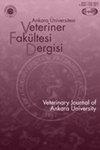土耳其断奶马驹胞内裂毛线虫的分子和血清学研究
IF 0.9
4区 农林科学
Q3 VETERINARY SCIENCES
引用次数: 0
摘要
在许多不同的国家,包括美国、西欧、以色列、韩国和巴西,在断奶马中都有由胞内Lawsonia引起的马增殖性肠病的报道,但在土耳其和东欧没有调查过。本研究的目的是测定断奶马驹中胞内乳杆菌的血清阳性率和粪便排出情况。设计了一项横断面研究,随机选择来自土耳其3个不同省份的97匹有或无临床症状的断奶马驹。用自动生化分析仪测定了97头马驹血清中总蛋白和白蛋白水平。血清和粪便分别采用bELISA和real-time PCR检测L.胞内特异性抗体和-DNA。elisa检测血清阳性率为25.8%。然而,所有粪便样本均未通过实时PCR检测呈阳性。统计学上,血清阳性与临床症状或血清ALB/TP水平无显著相关性。血清阳性表明,断奶马驹群体在土耳其首次暴露于胞内乳杆菌。需要进一步调查以更好地了解该疾病在该国/地区的断奶马以及成年马种群和潜在野生动物资源中的流行病学。本文章由计算机程序翻译,如有差异,请以英文原文为准。
Molecular and serological investigation of Lawsonia intracellularis in weanling foals in Turkey
Equine proliferative enteropathy caused by Lawsonia intracellularis has been described in weanlings in many different countries including the USA, Western Europe, Israel, Korea and Brazil but not investigated in Turkey and Eastern Europe. The objective of the study was to determine the seroprevalence and fecal shedding of L. intracellularis in weanling foals. A cross-sectional study was designed in randomly selected 97 weanling foals with or without clinical signs from 3 different provinces of Turkey. Total protein and albumin levels in serum samples from 97 foals were measured using automated biochemistry analyser. Serum samples and fecal samples were also tested by bELISA and real-time PCR to detect L. intracellularis-specific antibodies and -DNA, respectively. Seropositivity was found to be 25.8% by bELISA. However, none of the fecal samples were positive by real-time PCR. Statistically, no significant associations were found between seropositivity and clinical signs or serum ALB/TP levels. Seropositivity indicated the exposure of weanling foal population to L. intracellularis for the first time in Turkey. Further investigations are needed to better understand the epidemiology of the disease in the weanlings as well as adult horse populations and potential wildlife resorvoirs in the country/region.
求助全文
通过发布文献求助,成功后即可免费获取论文全文。
去求助
来源期刊
CiteScore
1.50
自引率
0.00%
发文量
44
审稿时长
6-12 weeks
期刊介绍:
Ankara Üniversitesi Veteriner Fakültesi Dergisi is one of the journals’ of Ankara University, which is the first well-established university in the Republic of Turkey. Research articles, short communications, case reports, letter to editor and invited review articles are published on all aspects of veterinary medicine and animal science. The journal is published on a quarterly since 1954 and indexing in Science Citation Index-Expanded (SCI-Exp) since April 2007.

 求助内容:
求助内容: 应助结果提醒方式:
应助结果提醒方式:


